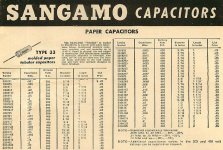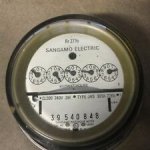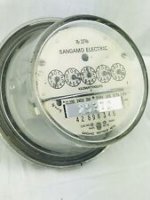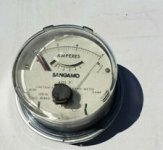Greetings. I recently received a modest quantity of NOS Sangamo caps.
They are greenish colored and marked Sangamo Type 33M .05 400
Axial, 1.25" long x .435" dia.
Advice requested: Treasure or Trash?
They are greenish colored and marked Sangamo Type 33M .05 400
Axial, 1.25" long x .435" dia.
Advice requested: Treasure or Trash?
Sangamo was mostly known for their mica capacitors many years ago. What you have is paper capacitors from around 1960. Catalog data is attached.
Whether they are trash or treasure depends on your point of view. To me they are trash but there might be a use for these caps in guitar amps or other tube amps for those who love vintage parts.
Whether they are trash or treasure depends on your point of view. To me they are trash but there might be a use for these caps in guitar amps or other tube amps for those who love vintage parts.
Attachments
If you measure them for leakage at full rated voltage, that will give you the answer.
Paper caps usually absorb moisture and will not last 59 years.
Paper caps usually absorb moisture and will not last 59 years.
Last edited:
Sangamo was mostly known for their mica capacitors many years ago.....
Maybe in this crowd. Sangamo name was on "most" electric power meters for the first half of my life... so perhaps more notorious than capacitors inside equipment.
Also "Thermal Demand" meters which integrated a customer's demand roughly-as the way it heated the utility equipment; if it was excessive for the average, there would be a surcharge.
It was a big company with many arms. I'm not sure what happened to it. EDIT-- Branched out of a watch company turn of century, bought by Schlumberger in the 1970s.
Sangamo Electric Co. | SangamonLink
Agree that old paper caps are not "treasure".
Attachments
Last edited:
Sangamo made practically everything. Where I work we have more than a few of the old Sangamo paper-in-oil caps (the HV bathtub types rated to 1kv+).
That said, the old paper-and-foil capacitors are all passed their date and really need to go. Check for leakage. It's possible they're a poly style cap, in which case they will have nearly zero leakage, but I would be surprised if they aren't a paper cap, in which case they are garbage.
That said, the old paper-and-foil capacitors are all passed their date and really need to go. Check for leakage. It's possible they're a poly style cap, in which case they will have nearly zero leakage, but I would be surprised if they aren't a paper cap, in which case they are garbage.
Thanks very much for the advice & information. I believe I will be giving these caps "The old heave-ho". I will keep the nice retro style carton they came in.
I recall buying a Sangamo ,very small, one digit 7 segment LED display in 1970, most likely from an ad in the back of Popular Electronics magazine.
That same year the U.S. Selective Service caused the project that I had envisioned for the part to be derailed.
I recall buying a Sangamo ,very small, one digit 7 segment LED display in 1970, most likely from an ad in the back of Popular Electronics magazine.
That same year the U.S. Selective Service caused the project that I had envisioned for the part to be derailed.
Last edited:
Its all about texture
I have been building and repairing tube amplifiers for say more than 5 years, being asked to repair old tube amplifiers for Audiophiles and Musicians each has a differant point of view the Audiophile is looking for perfect recorded replication the musician is looking for Texture when it comes to capacitors they play a great role in providing the escence of texture. My journey started with a burning Amp project ,I really did not know what i was about to experience ,thanks to one man (Nelson Pass) I was able to get some very rare components in Australia. Well I browned out the house on start up. but I can tell you I was blown away, the sonics were gorgeous. What on earth just happened? well I was introduced to world of amazing sonics. today i will taylor an amp to what the texture the client likes to here or wants to produce. One part is the venerable coupling capacitor with all its little quirks the saganamo type 33 is one of those little texture beasties, don't bag it use it for what it is, and create and pre amp, a guitar amp, a tone booster or fatener, restore a wurlitzer or just create a beautiful 1920s styled amp fatten it out, just live with the Glory of a Magificent component that adds a life to your build.
I have been building and repairing tube amplifiers for say more than 5 years, being asked to repair old tube amplifiers for Audiophiles and Musicians each has a differant point of view the Audiophile is looking for perfect recorded replication the musician is looking for Texture when it comes to capacitors they play a great role in providing the escence of texture. My journey started with a burning Amp project ,I really did not know what i was about to experience ,thanks to one man (Nelson Pass) I was able to get some very rare components in Australia. Well I browned out the house on start up. but I can tell you I was blown away, the sonics were gorgeous. What on earth just happened? well I was introduced to world of amazing sonics. today i will taylor an amp to what the texture the client likes to here or wants to produce. One part is the venerable coupling capacitor with all its little quirks the saganamo type 33 is one of those little texture beasties, don't bag it use it for what it is, and create and pre amp, a guitar amp, a tone booster or fatener, restore a wurlitzer or just create a beautiful 1920s styled amp fatten it out, just live with the Glory of a Magificent component that adds a life to your build.
These ancient paper capacitors will probably be leaking badly after 60 years or so of operation.
Never use them to block HVDC, or the leakage will wrongly bias the following tubes.
Never use them to block HVDC, or the leakage will wrongly bias the following tubes.
Last edited:
It doesn't matter if they have some special "mojo". If they are at all leaky, they go in the trash. I don't see why it's so hard to get people to throw trash in the garbage can. If you don't know how to test if they are leaky, then it's best to assume they are and pitch them.
If we were talking about some old Sangamo pulse discharge capacitors that each weigh 100 pounds and cost a fortune to buy new, then it might be worth hanging onto them. Since we're talking about 50 cent coupling capacitors (maybe $2 if you buy orange drops), I really don't see the point in risking it.
If we were talking about some old Sangamo pulse discharge capacitors that each weigh 100 pounds and cost a fortune to buy new, then it might be worth hanging onto them. Since we're talking about 50 cent coupling capacitors (maybe $2 if you buy orange drops), I really don't see the point in risking it.
- Home
- Design & Build
- Parts
- Sangamo Type 33M Caps



